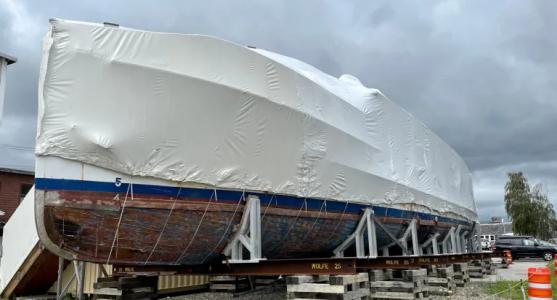 Good news. The Bangor Daily News is reporting that the restoration of the ex-presidential yacht Sequoia will begin soon in Belfast, Maine.
Good news. The Bangor Daily News is reporting that the restoration of the ex-presidential yacht Sequoia will begin soon in Belfast, Maine.
We first posted about the saga of the ex-presidential yacht in 2016 when Delaware judge Sam Glasscock describes her then-current condition. “The Sequoia, an elderly and vulnerable wooden yacht, is sitting on an inadequate cradle on an undersized marine railway in a moribund boatyard on the western shore of the Chesapeake, deteriorating and, lately, home to raccoons.”
Three years later we posted again, about the 104′ long motor vessel being loaded aboard a barge to be transported to Maine for restoration.
Now, following the pandemic and supply chain issues, Todd French of French & Webb, a local custom boat building company described the progress in the restoration of the historic yacht to the Bangor Daily News.
Little obvious work has been done on the Sequoia, but a lot has happened behind the scenes. That prep work has included using modern laser technology to make a full, three-dimensional model of the boat, and sourcing rare wood in environmentally sensitive ways.
“It’s slowly happening, but the needle is moving,” French said this week on a tour of the Sequoia. “As much as it’s a bit of an eyesore on the waterfront right now, it’s here, it’s protected — and it’s going to happen.”
Because the Sequoia is on the National Register, the restoration must be of museum-level archival caliber, French said. The owner, Michael Cantor, is choosing to do it as sustainably as possible.
One problem was how to source the replacement wood for the boat, which was constructed of longleaf pine. The tree is native to the southeastern U.S., and its high-quality lumber was used for building ships and railroads. But supplies were dwindling by the 1920s, when the Sequoia was built. There’s an effort to try to bring the trees back, and French was able to find some longleaf pine lumber after trees on conservation land in Georgia blew down in hurricanes. Now, 100,000 board feet of longleaf pine are drying in a Northport warehouse.
He also was able to find in Denmark a sustainable source for white oak, which was used for the framing. Lumber was cut from trees that had been planted in the early 1800s for the Danish Navy but were “aging out” and needed to be harvested, he said. French bought container loads that then were shipped to Maine.
“Anything we need, it has to be certified and responsible,” he said.
The shipbuilder also needed to make a good model of the Sequoia to use for the restoration because the original Trumpy plans couldn’t be found. After the boat first arrived, it underwent a lidar scan, a laser technology that uses light pulses to generate precise, three-dimensional information.
“What we did was model this as it is,” French said.
There are lots and lots of historic photographs and archival information, some of which the boat’s owner has paid researchers to track down, that are critical to figuring out what is original to the Sequoia and what has been added over the years.
“The goal here is to have a true accounting of the boat and its history,” French said.
If the aim was simply to repair the boat, it would be a much faster project, he said. French hopes to construct a building around the Sequoia with a walkway so that the public can watch the restoration work being done, which could be done as soon as next spring. Once the physical work on the Sequoia begins, it should be a three-year project, he said.
“This is a national treasure. It’s part of our shared Americana,” he said. “I think we can educate the general population about American history a little bit in a way that isn’t partisan. This project, I hope, can put some salve on our collective consciousness and approach to politics.”
The Sequoia served as a presidential yacht during the administrations of Herbert Hoover through Jimmy Carter and is a National Historic Landmark. Sequoia was originally launched as a private yacht in 1925. She was designed by John Trumpy and built by the John H. Mathis & Company Shipbuilders in Camden, New Jersey. She was purchased by the US government in 1931 after a brief stint as a naval vessel during Prohibition and became the official presidential yacht in 1933. After 46 years of government service, the Sequoia was sold at auction in 1977.
